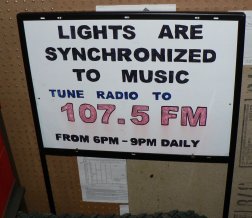History
The rough idea for the display was conceived just after the 2005 holiday season. It was planned casually during the first half of 2006 and then aggressively executed from August to November 2006 to finish by Thanksgiving in time for Christmas 2006. It ran daily through the new year with only 1 day of partial downtime due to water problems with one of the controllers. Fortunately the problem was identified and plans were put in place to avoid it in the future.
Motivation

A common (and fair) question is how someone goes from having four strands of christmas lights wired into an outdoor light socket (which we often forgot to turn on at night) to nearly 100 separate strands of lights being powered by two separate circuits and run by a precise software timer. This page will attempt to offer an explanation (although admitedly you will probably still be convinced we are crazy when you finish reading it).
Back around Christmas of 2005, the media heavily covered a Christmas display from Mason, Ohio. It was created by an electrical engineer named Carson Williams. I initially only heard about this second hand. Since I am an electrical engineer, friends told me about it with the insinuation that I too should participate in the madness. Initially I was not even tempted.
A few people asked me how something like this was possible. Knowing that Mr. Williams was an electrical engineer, I simply speculated that he designed and built his own control hardware to do the job. I could roughly envision what it would take, so I assumed that was how things played out in Mason, Ohio.
Shortly after the holidays, someone forwarded me an article that went into detail on Mr. William's display. It reported that he used 88 Light-O-Rama controllers to control the hardware. In all, the display allegedly cost about $10,000. I was disappointed. I had assumed that everything had been designed from scratch, but it turned out that a commercial product was behind it all. And that's when I really got to thinking...
After pondering the idea a little bit, I began to mentally thinking through some options for designing a system like this. I researched electronic components only briefly and declared to my wife that I though I could design the functional equivalent of the $10,000 commercial system for about $1,000. Much to my surprise, she thought it sounded like a good idea.
Now this is where I need to pause for some explanation. My wife was fully on board with this project. She thought it sounded fun and having animated Christmas lights would be entertaining. I asked her several times if she really wanted to do this and she agreed. I point this out because she later would regret this decision at times. What she didn't know going into this that I did, was that it would require lots of hard work, soldering, assembly, splicing wires, etc. to make this a reality. It was a dream for me because it allowed me to justify buying some basic electronic assembly equipment. My wife did not know what she was in for yet.
I am not a big fan of reinventing the wheel, but I am even a lesser fan of spending $10,000. Having accepted that I was about to reinvent something for novelty's sake, I saw no need to seek out existing solutions. Instead I was determined to do the entire project from scratch myself. After all, this was the underlying principle that originally attracted me to the project. Because of this, I did not do any research on existing solutions.
Fast forward 11 months to December 2006 and we had the display running in our front yard. The project was extremely successful. It ended up being rather time consuming though. My wife was glad when the planning stage finally wrapped up and we shut down the nightly workshop factory in our living room.
After finishing, I later discovered that there were many other Christmas light fanatics out there on the internet with documented designs. Many of the designs are relatively simple and do not necessarily scale well. Several make partial use of commercial controllers. A few are equivalent to what I designed. Each has their pros and cons.
Since completing the project, I cleaned up the software and made a public release for others to use to control their holiday lighting displays. The software was rather innovative and took a different approach than existing tools with an emphasis on simulation from the ground up. This was important for me since I knew that I needed to design the sequences before the hardware would be finished and installed.
For more information the software and how you can use it to design your own animated sequences, see the software page.